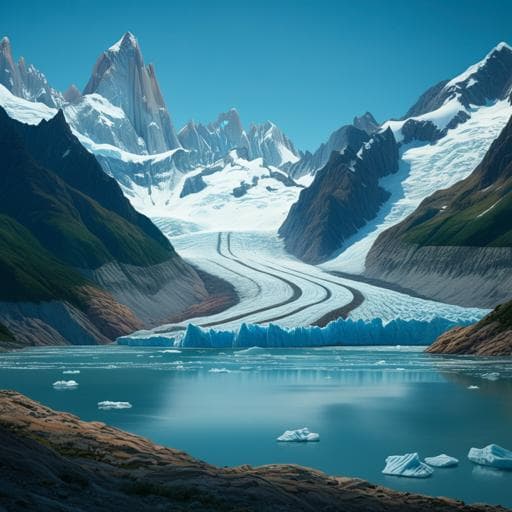
Earth Sciences
Nonlinear sensitivity of glacier mass balance to future climate change unveiled by deep learning
J. Bolibar, A. Rabatel, et al.
Discover groundbreaking findings on glacier evolution projections conducted by Jordi Bolibar, Antoine Rabatel, Isabelle Gouttevin, Harry Zekollari, and Clovis Galiez. This study reveals that glaciers in the French Alps are projected to lose up to 88% of their volume by the end of the century, challenging traditional models and impacting future water resources and sea-level rise predictions.
~3 min • Beginner • English
Introduction
The study addresses how glaciers in the French Alps will evolve through the 21st century and how their mass balance responds to future climate forcing. Glaciers are retreating globally with major implications for water resources, hydropower, ecosystems, hazards, and society. Large-scale glacier models must represent mass balance (accumulation versus ablation) and ice dynamics, but simplifying assumptions are needed. While efforts have improved ice dynamics, most large-scale projections still use temperature-index mass balance models that impose linear sensitivities between positive degree-days and melt. Given the inherently nonlinear behavior of the climate–glacier system, this raises concerns about biases under changing climates. The authors develop and apply, to their knowledge, the first deep learning-based glacier evolution projections to quantify nonlinear mass balance responses and their implications under multiple climate scenarios (RCP 2.6, 4.5, 8.5) for the French Alps, a region with extensive observations and rapid glacier loss. They investigate how nonlinearities affect projections, especially under different topographic contexts (steep mountain glaciers versus flatter, ice cap-like configurations).
Literature Review
Global glacier evolution projections have been widely explored using temperature-index models due to their parsimony and suitability where observations are sparse, sometimes outperforming more complex models under past climates. However, temperature-index approaches linearize relationships between positive degree-days, precipitation, and mass balance, despite known nonlinearities in climate–glacier interactions. Previous ANN applications to glaciology were limited to shallow networks for single glaciers’ ice thickness or mass balance. GlacierMIP intercomparisons have aggregated global-scale projections but all rely on linear degree-day type mass balance formulations (with single or multiple degree-day factors). Prior work also highlights that model uncertainties are dominated by future climate scenarios, but model structural uncertainty is substantial early in the century. Energy balance studies indicate decreasing melt sensitivity (degree-day factors) with warming, especially for ice and during summer, implying potential oversensitivity of temperature-index models under future climates. This study builds on and compares to state-of-the-art models (e.g., GloGEMflow) and explores the effect of nonlinearities on projections.
Methodology
Mass balance modelling: Annual glacier-wide mass balance (MB) for individual glaciers is simulated via two approaches: (1) a deep learning model (feed-forward multilayer perceptron) and (2) a linear model (Lasso regularized multilinear regression). The deep network architecture is 40-20-10-5-1 with Leaky-ReLU activations, He uniform initialization, RMSprop optimization, batch normalization, dropout, and Gaussian noise regularization; output layer is linear. The Lasso provides linear sensitivities with parameter shrinkage/selection. Training data comprise 32 French Alpine glaciers with 1048 annual glacier-wide MB observations (1967–2015), using topographic and climate predictors per glacier-year. Topographic predictors (updated annually) include mean and maximum glacier altitude, slope of lowermost 20% altitudinal range, surface area, latitude, longitude, and aspect. Climate predictors (anomalies relative to 1967–2015 at mean glacier altitude) include annual cumulative positive degree-days (CPDD), winter snowfall, summer snowfall, and monthly mean temperature and snowfall, totaling 34 predictors (7 topographic, 3 seasonal, 24 monthly). Climate observations for training use the SAFRAN reanalysis tailored for French mountainous terrain.
Cross-validation and ensemble: To avoid overfitting and respect spatiotemporal structure, three cross-validations were used: Leave-One-Glacier-Out (LOGO), Leave-One-Year-Out (LOYO), and Leave-Some-Years-and-Glaciers-Out (LSYGO). Spatiotemporal performance (LSYGO) for deep learning achieved RMSE 0.59 m w.e. a−1 and r=0.69; Lasso achieved RMSE 0.85 m w.e. a−1 and r^2=0.353. Projections used a cross-validation ensemble of 60 models (LSYGO-based), averaging outputs across ensemble members.
Climate forcing: Future MB is forced by ADAMONT-adjusted EURO-CORDEX climate projections specific to French mountains, providing 29 GCM–RCM–RCP members (RCP 2.6, 4.5, 8.5) at high spatial resolution with elevation/aspect bands.
Glacier geometry evolution: Annual redistribution of mass changes over each glacier uses a glacier-specific parameterization of geometry change (empirical functions) derived from two DEMs (1979 photogrammetric and 2011 SPOT-5) resampled to 25 m. For each glacier >0.5 km^2 (≈80% of 2015 area), an elevation-dependent surface change function (1979–2011) captures dynamics and is applied annually to update DEM, ice thickness, and topographic predictors, thus adjusting mean altitude and the climate signal (topographical feedback). Glaciers <0.5 km^2 are treated as mainly downwasting remnants with uniform mass change application. Initial ice thickness (2003) is from consensus products with adjustments: Argentière uses combined observations and simulations; Mer de Glace thickness increased by 25% to match observations. Validation for 2003–2015 compares simulated areas to 2015 inventory; sensitivity tests vary initial thickness (±30%) and geometry parameterization (±10%). Initial thickness is identified as a major model uncertainty after climate forcing.
Model comparison and nonlinear sensitivity extraction: To isolate MB-model effects, simulations are run identically except for the MB model (deep vs Lasso). A synthetic experiment deactivates geometry updates (constant mean altitude) to emulate ice cap-like behavior lacking topographical feedback. Model sensitivity analyses modify single predictors regionally across 1967–2015 data: CPDD anomalies (−1500 to +1500 PDD), winter snowfall anomalies (−1500 to +1500 mm), and summer snowfall anomalies (−1000 to +1000 mm), applied seasonally, to compare linear vs nonlinear responses.
Comparison to an independent model: Results are compared to GloGEMflow (temperature-index with separate degree-day factors) adjusted for comparability: forced with the same 29 climate members, MB bias-corrected for 2003–2015 (−0.4 m w.e. a−1) over the French Alps, and acknowledging small differences in initial thickness and dynamics. Altitude differences between models are <50 m on average.
Key Findings
- Strong projected glacier loss in the French Alps across all climate members: average volume loss by 2100 relative to 2015 is 75% (RCP 2.6, ±9%, n=3), 80% (RCP 4.5, −17%/+11%, n=13), and 88% (RCP 8.5, −15%/+11%, n=13).
- Mass balance trajectories: under RCP 4.5, annual glacier-wide MB remains around −1.2 m w.e. a−1 throughout the century as upward retreat offsets warming; under RCP 8.5, MB becomes increasingly negative in the second half, approaching roughly twice today’s negative values; under RCP 2.6, MB trends toward equilibrium by late century, with potential stabilization in early 22nd century depending on response time.
- Climate drivers: Summer air temperature is the main driver of future mass change at evolving mean glacier altitudes. Despite warming, annual snowfall at glacier mean altitude remains approximately constant due to higher precipitation in the ensemble and glacier retreat to higher, wetter elevations; solid/liquid precipitation ratio remains relatively stable.
- Spatial distribution: The Mont-Blanc massif held ~60% of 2015 ice volume (7.06 of 11.64 km^3). Most small, low-elevation glaciers largely disappear outside Mont-Blanc and Pelvoux by 2100.
- Nonlinear vs linear MB model performance and sensitivity: Deep learning exhibits higher explained variance and lower error than Lasso. Spatiotemporal CV (LSYGO): DL RMSE 0.59 m w.e. a−1 (r=0.69); Lasso RMSE 0.85 m w.e. a−1 (r^2=0.353). Sensitivity analysis yields r^2≈0.76 (DL) vs 0.41 (Lasso) for reproducing MB response surfaces. Linear model fits mean conditions but misrepresents extremes, overestimating both extreme positive and negative MB rates; oversensitivity is largest for summer snowfall anomalies and at extreme CPDD anomalies.
- Scenario dependence and topographical feedback: Differences between models are largest under RCP 2.6, where linear models predict more frequent positive MB and near-equilibrium late-century, unlike DL. With topographical feedback (mountain glaciers), cumulative MB differences up to ~17% regionally by 2100 (RCP 2.6); under RCP 4.5 and 8.5, differences are smaller overall, except for some large, long-response-time glaciers (e.g., up to ~75% difference under RCP 8.5 for Mer de Glace-scale glaciers).
- Ice cap-like behavior (no topographical feedback): Synthetic experiments with constant mean altitude show more frequent extreme negative MB and larger divergences between DL and linear models across most scenarios, with cumulative MB differences up to ~20% by 2100, implying stronger nonlinear effects for flat glaciers/ice caps.
- Comparison with a temperature-index model (GloGEMflow): End-of-century regional volume differences are relatively small (e.g., ~14% for RCP 2.6, <2% for RCP 4.5), but annual MB patterns show that temperature-index and Lasso (both linear) simulate more positive MB under RCP 2.6 and display oversensitivity consistent with linear assumptions.
- Physical interpretation: Energy balance considerations and observations indicate decreasing degree-day factors (e.g., snow DDF decline ~−7% per decade in the Alps), especially for summer and ice surfaces, yielding reduced melt sensitivity at higher temperatures—nonlinear behavior captured by DL but not by linear models.
Discussion
The research demonstrates that glacier mass balance responds nonlinearly to climatic forcings, particularly under extreme conditions and during the ablation season. Deep learning captures these nonlinearities, improving representation of extreme mass balance rates and reducing biases relative to linear models. The findings address the central question by quantifying how nonlinear sensitivities alter projections under different RCPs and topographic contexts. For mountain glaciers, geometry-driven topographical feedback (retreat to higher elevations) mitigates warming effects, making linear models mostly adequate under intermediate-to-high emissions but biased under low-emissions scenarios where stabilization is possible. In contrast, flatter glaciers and ice caps lack this feedback; thinning can even enhance warming at the surface, increasing the frequency of extreme negative mass balance and amplifying nonlinear effects—conditions where linear models produce significant negative biases. The study contextualizes these behaviors physically: future warming elevates the importance of longwave and turbulent fluxes relative to shortwave, reducing degree-day factors and melt sensitivity (especially for ice in summer), leading to nonlinear responses that linear degree-day formulations cannot emulate. The implications are broad: widespread use of temperature-index models in global projections may underestimate mass loss under low emissions (by overstating positive MB episodes) and overestimate losses under high emissions (due to persistent oversensitivity), with consequences for sea-level rise and water resource forecasts. The results underscore the need for updated MB parameterizations that incorporate nonlinear sensitivity, especially for regions dominated by ice caps where uncertainties are largest.
Conclusion
This work presents the first deep learning-based regional glacier evolution projections, revealing pronounced nonlinear sensitivities of glacier mass balance to temperature and precipitation. Projections for the French Alps indicate 75–88% volume loss by 2100 across RCP 2.6–8.5, with mass balance trends and climate drivers dominated by summer temperature at evolving glacier altitudes. Deep learning reduces error and bias, particularly for extremes, relative to linear statistical and temperature-index approaches. For steep mountain glaciers, linear models are generally adequate under intermediate and high emissions but introduce positive biases under low emissions (RCP 2.6). For flat glaciers and ice caps, linear models likely yield negative mass balance biases across scenarios, implying long-term biases in sea-level and water resource projections. The study advocates for developing nonlinear mass balance parameterizations that reflect reduced melt sensitivity at higher temperatures, especially during summer and for ice surfaces, and for incorporating such schemes or hybrid physics–ML methods into large-scale models. Future work should extend to ice-cap-focused experiments including ice–ocean interactions and thermodynamics, improve initial ice thickness constraints, and leverage emerging scientific machine learning frameworks to bridge process understanding and data-driven modelling.
Limitations
- Scope and transferability: The primary application is to French Alpine glaciers; implications for other regions, especially ice caps, are inferred via synthetic experiments rather than dedicated ice-cap models.
- Synthetic ice cap experiment: Emulates lack of topographical feedback by fixing mean altitude and does not simulate surface area changes or potential thinning-driven lowering into warmer air (which could further increase negative MB), potentially underestimating nonlinear impacts.
- Process interpretability: The deep neural network behaves as a black box; while sensitivity analyses elucidate responses, physical process attribution is limited compared to full energy balance models.
- Data limitations: Large-scale energy balance modelling is constrained by input data availability; training relies on 32 glaciers and 1048 glacier-year MB values (1967–2015), which may limit representation of rare extremes.
- Initial conditions and geometry parameterization: Initial ice thickness is a major uncertainty; local biases up to 100% exist in some thickness estimates, though adjustments were applied for key glaciers. Geometry update relies on empirically derived elevation-change patterns from 1979–2011, assuming representativeness over the projection period.
- Forcing uncertainty: Dominant uncertainties arise from future climate scenarios (RCP/GCM/RCM), especially in the second half of the 21st century; model structural uncertainty plays a larger role in the first half.
- Comparison model adjustments: Bias corrections and differing calibration datasets (e.g., Swiss vs French MB data) affect comparability with external models (GloGEMflow).
Related Publications
Explore these studies to deepen your understanding of the subject.







